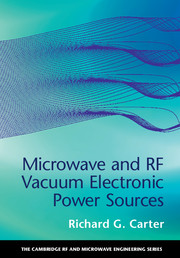Crossref Citations
This Book has been
cited by the following publications. This list is generated based on data provided by Crossref.
Guha, Raktim
Bandyopadhyay, Ayan K.
Varshney, Amit K.
Datta, Subrata K.
and
Basu, Baidyanath
2018.
Investigations into Helix Slow-Wave Structure Assisted by Double-Negative Metamaterial.
IEEE Transactions on Electron Devices,
Vol. 65,
Issue. 11,
p.
5082.
Jadhav, Aviraj R.
John, Joseph
Tuckley, Kushal
Dixit, Harish V.
and
Sharma, P. K.
2019.
Conceptual RF design of 3.7 GHz 20 kW CW Magnetron for LHCD system of Tokamaks.
p.
1.
Jassem, Abhijit
Wong, Patrick Y.
Chernin, David P.
Lau, Y. Y.
Antoulinakis, Foivos
Packard, Drew
Hargreaves, Thomas A.
and
Armstrong, Carter M.
2019.
Extensions of Johnson’s Theory of Backward-Wave Oscillations in a Traveling-Wave Tube.
IEEE Transactions on Electron Devices,
Vol. 66,
Issue. 3,
p.
1519.
Chung, Shen Shou Max
and
Tuan, Shih-Chung
2019.
Influence of the Magnetic Field and Impedance of Pulsed Power System on the Resonance of Magnetron with Diffraction Output.
p.
1.
Bansiwal, Ashok
Raina, Sushil
Vinoy, K. J.
and
Datta, Subrata Kumar
2019.
Equivalent Circuit Analysis of a Rectangular Double-Reentrant Cavity With Circular Cylindrical Ferrule for Klystrons.
IEEE Transactions on Electron Devices,
Vol. 66,
Issue. 11,
p.
4952.
Srivastava, Vishnu
2019.
Design of a Microfabricated Planar Slow Wave Structure for a 0.22-THz TWT for Communication, Imaging and Remote Sensing.
IETE Technical Review,
Vol. 36,
Issue. 5,
p.
501.
Ur Rehman, Zia
Noor, Syed Ahmed
Khan, Riaz
Ur Rehman, Aman
Hussain, Shahid
Ali, Ahmad
and
Shakir, Sehrish
2020.
Design and simulation of a high fidelty multi-stage power converter for pre-heating of industrial magnetrons.
p.
1.
Joshi, Mohit Kumar
Vyas, Sandeep Kumar
Tiwari, Tapeshwar
and
Bhattacharjee, Ratnajit
2020.
A New Approach for High-Power Coaxial Magnetron Using Stacked Anode Resonators.
IEEE Transactions on Electron Devices,
Vol. 67,
Issue. 4,
p.
1808.
Bansiwal, Ashok
Raina, Sushil
Vinoy, K. J.
and
Datta, Subrata Kumar
2020.
A Post-Loaded Rectangular Reentrant Cavity for Broadband Multiple-Beam Klystron.
IEEE Electron Device Letters,
Vol. 41,
Issue. 6,
p.
916.
Srivastava, Anurag
2020.
Design and simulation of ring-bar slow-wave structure TWT at Ku-band with power over 1200 watts.
Journal of Electromagnetic Waves and Applications,
Vol. 34,
Issue. 11,
p.
1550.
Troncoso, G.
García-Martín, J.M.
González, M.U.
Morales, C.
Fernández-Castro, M.
Soler-Morala, J.
Galán, L.
and
Soriano, L.
2020.
Silver nanopillar coatings grown by glancing angle magnetron sputtering for reducing multipactor effect in spacecrafts.
Applied Surface Science,
Vol. 526,
Issue. ,
p.
146699.
Joshi, Mohit Kumar
Vyas, Sandeep Kumar
Tiwari, Tapeshwar
and
Bhattacharjee, Ratnajit
2020.
Particle-in-Cell Simulation and Analysis of 28-Vane Megawatt-Class Pulsed Power Coaxial Magnetron in X-Band.
IEEE Transactions on Plasma Science,
Vol. 48,
Issue. 6,
p.
1886.
Khan, Noman
Abbas, Tanveer
Zia-Ur-Rehman
Abdullah
and
Khan, Riaz
2020.
A Stacked Resonant High Voltage DC Modulator for Industrial Magnetron.
p.
1.
Jadhav, Aviraj R.
John, Joseph
Tuckley, Kushal
Sharma, P. K.
and
Dixit, Harish V.
2020.
On the Frequency Scaling of High Power CW Magnetrons.
p.
1.
Behtouei, Mostafa
Spataro, Bruno
Faillace, Luigi
Carillo, Martina
Leggieri, Alberto
Palumbo, Luigi
and
Migliorati, Mauro
2021.
Relativistic versus Nonrelativistic Approaches to a Low Perveance High Quality Matched Beam for a High Efficiency Ka-Band Klystron.
Instruments,
Vol. 5,
Issue. 4,
p.
33.
P, Prasanna Kumar
and
Saxena, Prerna
2021.
A novel bandpass filter fed antipodal tapered slot antenna for millimeter wave imaging.
International Journal of RF and Microwave Computer-Aided Engineering,
Vol. 31,
Issue. 12,
Khan, Noman
Abbas, Tanveer
Shehzad, Khurram
Khan, Riaz
and
Zia-Ur-Rehman
2021.
Control of a High Voltage DC Modulator for an Industrial Magnetron.
p.
1.
Luo, Jirun
Feng, Jinjun
and
Gong, Yubin
2021.
A Review of Microwave Vacuum Devices in China: Theory and Device Development Including High-Power Klystrons, Spaceborne TWTs, and Gyro-TWTs.
IEEE Microwave Magazine,
Vol. 22,
Issue. 4,
p.
18.
Paoloni, Claudio
Gamzina, Diana
Letizia, Rosa
Zheng, Yuan
and
Luhmann, Neville C.
2021.
Millimeter wave traveling wave tubes for the 21st Century.
Journal of Electromagnetic Waves and Applications,
Vol. 35,
Issue. 5,
p.
567.
Gharaati, Abdolrasoul
and
Mardani, Dariush
2021.
Electrostatic Design and Fabrication a New Tunable Perveance Pierce Electron Gun.
IEEE Transactions on Electron Devices,
Vol. 68,
Issue. 1,
p.
318.



